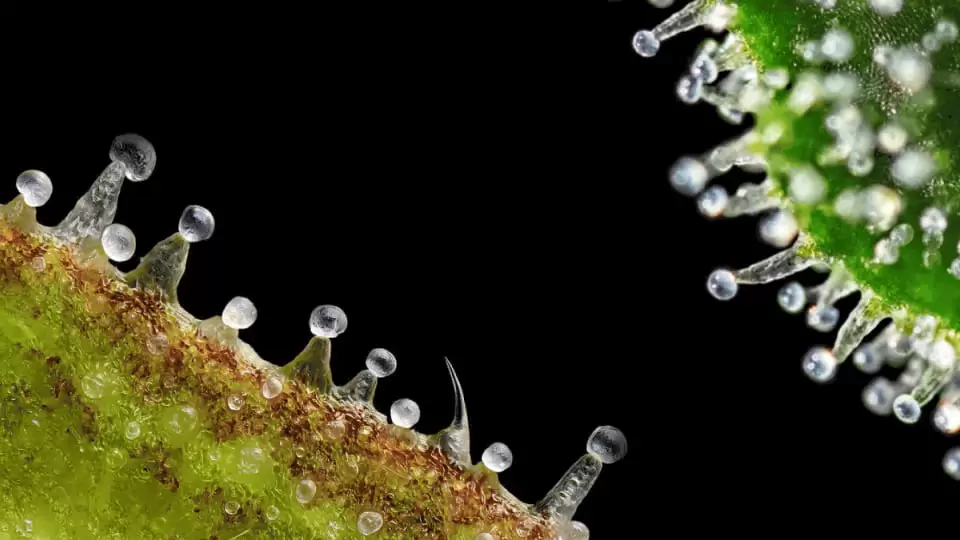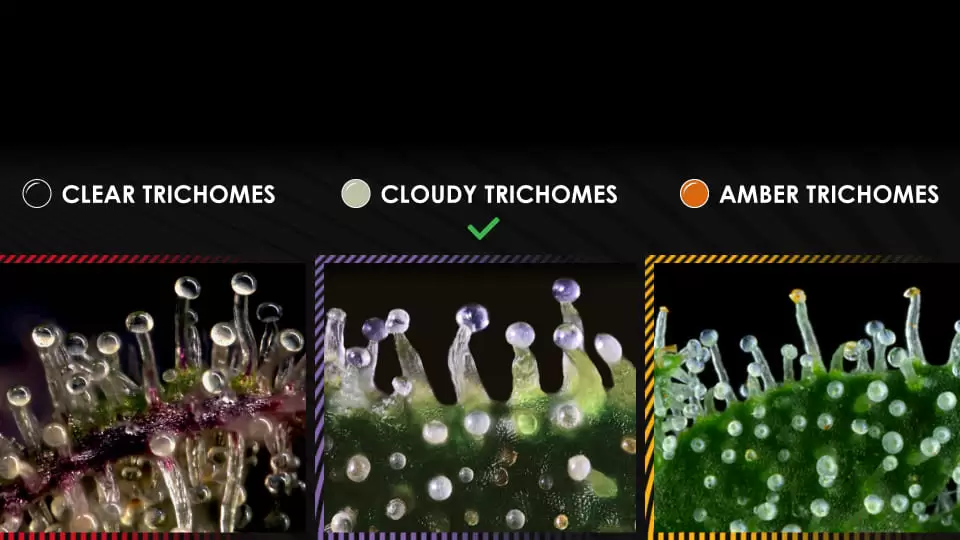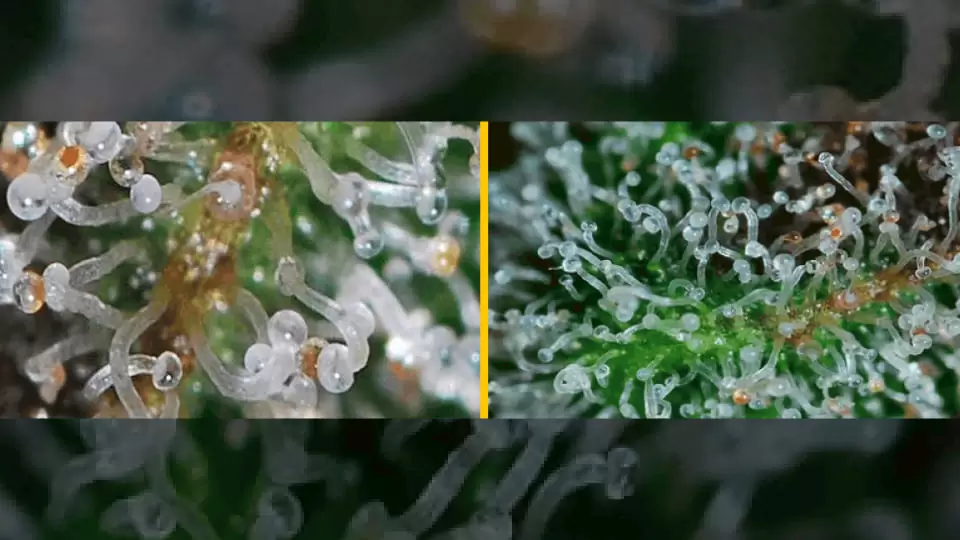Lemon Cherry Gelato

Crystal Coated Cannabis Buds
Energizing Daytime Experience
Fresh Citrus Symphony
Ideal for Green House Cultivation
Ideal for Indoor Cultivation
Up to 25% THC

Venture into the microscopic world of cannabis trichomes and uncover the secrets behind their magical potency. Let Hypno Seeds be your guide in this enchanting journey into the heart of your favorite cannabis strains. Choosing top autoflowering cannabis seeds ensures a hassle-free growing experience with high trichome production and fast flowering times.
Emerging from the Greek term τρίχωμα (tríkhōma) which translates as ‘growth of hair’, trichomes are the minute, glossy, sticky crystals you see hugging your cannabis buds. These unassuming entities are chemical factories that synthesize cannabinoids, terpenes, and flavonoids, thereby defining the unique characteristics and effects of each strain. Beyond manufacturing plant chemicals, trichomes play a crucial role in cannabis biology, which we’ll dive into next.

Mother Nature has thoughtfully equipped cannabis with trichomes as a defense mechanism. Their unpleasant taste and strong smell deter herbivores, while their stickiness entraps unwanted pests. Moreover, trichomes offer protection against harmful UV rays and strong winds. How does this benefit you, the cultivator, or the consumer? Simple, a healthier plant translates to high-quality, potent buds teeming with a unique blend of therapeutic compounds.
Primarily, cannabis trichomes are categorized into three types: Bulbous, Capitate-Sessile, and Capitate-Stalked. While each type boasts a unique appearance and location on the plant, the true champions of cannabinoid production are the Capitate-Stalked trichomes. Gaining insights into these types gives us a sneak peek into the plant’s complex biochemistry and the potent effects it can offer.

Starting with the smallest, we have the bulbous trichomes. Although they’re tiny (around 15-30 micrometers), they’re found all over the surface of the plant. Bulbous trichomes consist of a short stalk and a gland where the magic happens – the production of cannabinoids and terpenes. Because of their minuscule size, they don’t contribute much to the overall cannabinoid and terpene production, but every bit counts, right?
Next up, the middleweights: the Capitate-Sessile trichomes. They’re larger than the bulbous type and have both a stalk and a head, which is where cannabinoid and terpene synthesis occurs. While they’re more plentiful on the plant, their contribution to the cannabinoid and terpene profile is still relatively small compared to our heavy hitters coming up next.
Finally, we have the stars of the show: the Capitate-Stalked trichomes. These are the ones you can actually see on your cannabis buds, appearing like fine, crystal-like dust. They’re made up of a long stalk topped by a spherical gland, which is the primary site of cannabinoid and terpene synthesis. These trichomes have the highest concentration of cannabinoids and terpenes, thus playing a significant role in dictating the potency and effect of a cannabis strain.
As we’ve highlighted earlier, trichomes are veritable chemical factories, synthesizing a broad range of cannabinoids and terpenes that give each cannabis strain its distinctive profile. But let’s delve deeper into the biology behind this remarkable process.
Cannabinoids and terpenes are secondary metabolites of the cannabis plant, meaning they’re not directly involved in growth, development, or reproduction, but they play crucial roles in plant survival. In essence, they are part of the plant’s defense mechanism, deterring herbivores, attracting pollinators, and protecting the plant from harmful UV rays.

Cannabinoids, including THC, CBD, and more than 100 others, are produced in the glandular cells of the trichomes. These molecules start as cannabigerolic acid (CBGA), the mother of all cannabinoids. From CBGA, enzymatic reactions transform it into the acidic forms of THC, CBD, and CBC, which are then decarboxylated (usually through heat) into the cannabinoids we’re most familiar with.
Terpenes are synthesized in the same trichomes and are responsible for the wide variety of fragrances and flavors found in cannabis—from piney and citrus to sweet and earthy. If you’re looking for strains that excel in terpene and trichome production, high-resin sativa seeds are an excellent choice for flavorful and aromatic buds.
Yes, all trichomes on a cannabis plant have the capability to produce cannabinoids and terpenes. However, it’s the capitate-stalked trichomes—the largest and most abundant type—that are the main factories. Smaller trichomes like capitate sessile and bulbous trichomes also produce these compounds but in much smaller quantities.
Just like the cannabis plant, trichomes also go through a lifecycle. Starting from an initial translucent state, they eventually transition to a milky white color. As they mature further, they take on an amber hue. This color change is a vital indicator for cultivators when deciding the best time to harvest for optimal potency and effect.
Now let’s dive into a detailed timeline that illustrates the stages of trichome development during the flowering phase. This table considers both photoperiod and autoflowering strains:
| Week of Flowering | Trichome State | Description |
| 1-2 | Formation | Trichomes start to form, appearing clear and glass-like. |
| 3-4 | Early Maturation | Trichomes grow, still mostly clear but may start to turn cloudy. |
| 5-6 | Full Maturation | Trichomes become cloudy, reaching their peak in cannabinoid production. |
| 7+ | Degradation | Trichomes begin to turn amber, indicating the cannabinoids are starting to degrade. |
Remember, these timelines are averages and can vary depending on the specific strain and your unique growing conditions. Monitor your plants closely and make decisions based on their individual progress.
When it comes to growing cannabis, one of your primary goals should be to enhance trichome production. More trichomes often mean more potent, flavor-rich buds. Here are a few general tips to help you boost your trichome production:
Lighting: Cannabis trichomes serve as a plant’s natural sunscreen, protecting it against harmful UV rays. Using UVB light during the flowering stage can stimulate trichome production.
Nutrients: Balanced nutrition is vital. Too few nutrients can limit trichome production, while too many can burn your plants. Calcium and magnesium are particularly important for trichome development.
Temperature and Humidity: Trichomes also help the cannabis plant retain moisture. Keeping your grow room’s temperature and humidity in the ideal range for cannabis (around 70-80°F (21-27°C) and 40-70% relative humidity) can promote trichome growth.
Strain Selection: Some strains naturally produce more trichomes than others. Research your seeds before you plant them. If you’re seeking maximum potency, high-THC strains for trichome-rich buds are the best choice for resin-packed flowers.
Stress Training Techniques: Certain plant training techniques, like Low Stress Training (LST) and High Stress Training (HST), can stress the plant in a way that promotes trichome production.
Being able to correctly inspect your cannabis trichomes is a critical skill for any grower. Here’s a straightforward guide to help you master the art of trichome inspection:
Step 1: Gather Your Tools: You’ll need a jeweler’s loupe, microscope, or a camera with a good macro function. Trichomes are tiny, and a close-up view is necessary to assess their state accurately.
Step 2: Select a Bud: Choose a bud from the upper middle portion of your plant. Trichomes mature at different rates across the plant, and this area generally gives a good indication of overall readiness.
Step 3: Focus on the Trichomes: Position your tool of choice over a small cluster of trichomes. Aim for clear, steady images. It might take a little practice, but you’ll get the hang of it.
Step 4: Assess the Trichomes’ Color: Clear trichomes indicate that they’re still maturing. Cloudy trichomes signal peak THC levels, while amber trichomes suggest the THC is starting to degrade into CBN, which has different effects.
Step 5: Make Your Decision: If you’re after a more energetic high, harvest when most trichomes are cloudy. If you prefer a couch-lock effect, wait until many have turned amber.
Step 6: Check Multiple Buds: Check a few more buds around your plant to confirm your assessment. Plants don’t always ripen uniformly.
Timing your harvest based on trichome color is an art that can make all the difference in your final product’s quality and effects. Let’s take a more in-depth look at each trichome coloring stage:
Clear Trichomes: During this stage, trichomes resemble tiny glass mushrooms. This signals that they’re still in the growth phase, producing cannabinoids. Harvesting at this stage is typically too early, and the resulting buds may be less potent and lack the full spectrum of flavors and effects.

Cloudy Trichomes: As trichomes mature, they transition from clear to a milky or cloudy appearance. This stage signifies peak THC concentration, often producing more uplifting and psychoactive effects. If you’re seeking buds with high THC and more energetic effects, this is your moment to harvest.
Amber Trichomes: Over time, cloudy trichomes will turn a beautiful amber color. This change indicates the degradation of THC into CBN, a cannabinoid known for its calming, sedative effects. Harvesting during this stage will generally result in a more relaxing, body-centered high.

Overripe Trichomes: Eventually, trichomes can become too ripe and begin to wither. Overripe trichomes might lose their heads and look like tiny stalks. Harvesting at this stage can lead to less potent buds, as most of the beneficial cannabinoids and terpenes have started to degrade.
During Growth: Regularly inspect your plants using a magnifying glass to ensure trichomes are forming and maturing appropriately. Avoid touching the buds, and handle your plants from the base to avoid damaging the trichomes.
Trimming: Opt for dry trimming over wet trimming. Wet trimming can cause trichomes to stick to your scissors and may lead to accidental damage. Dry trimming is gentler on the trichomes, and while it might be slightly more labor-intensive, the preservation of trichomes makes it worth the effort.
Ideal Drying Conditions: Maintain a room with 50-60% humidity and temperatures between 18-21°C (64-70°F) during the drying process. This protects the trichomes from becoming brittle and breaking off.
Proper Curing: Cure your buds in airtight jars in a dark, cool space. This helps to fully develop the flavors while preserving trichomes. Remember to ‘burp’ your jars regularly in the early stages of curing to release moisture.
Storage: Store your cured buds in a dark, cool place, as light and heat can degrade cannabinoids over time. Glass jars are great for long-term storage.
Grinding: Use a high-quality grinder and be gentle. This reduces the chances of damaging your trichomes.
When it comes to cannabis extracts, trichomes are the star of the show. These glittering structures are the origin point of the potent oils that go into your favorite concentrates. But how does this process work?
Essentially, extraction techniques aim to separate the trichomes (and their precious cannabinoid and terpene contents) from the plant material. The most common methods include solvent-based extraction using substances like butane or CO2, and solventless methods like dry sift or ice water extraction.
Each method has its pros and cons, but all focus on collecting trichomes to create a concentrated cannabis product. From soothing tinctures to powerful shatter, the magic starts with the trichomes.
Indeed, trichomes are not exclusive to cannabis. They’re a common feature in the plant kingdom, serving different functions depending on the species. You can find trichomes on many plants, including nettles, tomatoes, and mint.
In some plants, trichomes serve a protective function, deterring pests with a bitter taste or sharp structure. In others, they help the plant retain moisture. Despite the differences, the basic idea is the same: trichomes help plants survive and thrive in their environment.
In conclusion, trichomes are an essential and fascinating part of the cannabis plant, influencing potency, flavor, and the overall growing experience. Understanding trichomes can greatly enhance your appreciation of this remarkable plant. As always, happy growing from all of us here at Hypno Seeds! Don’t forget to check out our exclusive cannabis seed promotions to get the best deals on high-quality genetics.

Are you 21 or older?
You must verify that you are 21 years or older to enter this website. By proceeding, you are also agreeing to our terms and conditions, as well as consenting to the use of cookies on this site.